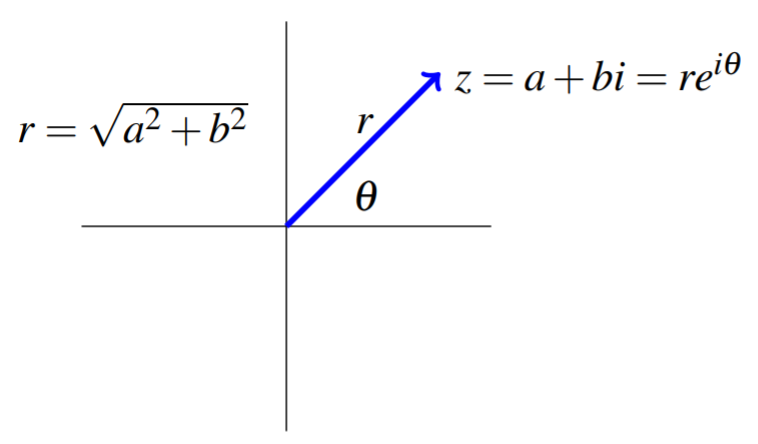6.2: Forma polar
( \newcommand{\kernel}{\mathrm{null}\,}\)
- Convierta un número complejo de forma estándar a forma polar, y de forma polar a forma estándar.
En la sección anterior, identificamos un número complejoz=a+bi con un punto(a,b) en el plano de coordenadas. Hay otra forma en la que podemos expresar el mismo número, llamada la forma polar. La forma polar es el foco de esta sección. Se va a resultar muy útil si no crucial para ciertos cálculos como pronto veremos.
Supongamos quez=a+bi es un número complejo, y vamosr=√a2+b2=|z|. Recordemos quer es el módulo dez. Tenga en cuenta primero que(ar)2+(br)2=a2+b2r2=1
A menudo hablamos del argumento principal dez. Este es el ángulo únicoθ∈(−π,π] tal quecosθ=ar, sinθ=br
La forma polar del número complejoz=a+bi=r(cosθ+isinθ) se escribe por conveniencia como:z=reiθ
Dejarz=a+bi ser un número complejo. Entonces la forma polar dez se escribe comoz=reiθ
Cuando se le daz=reiθ, la identidadeiθ=cosθ+isinθ se convertirá dez nuevo a forma estándar. Aquí pensamos eneiθ como un atajo paracosθ+isinθ. Esto es todo lo que necesitaremos en este curso, pero en realidad seeiθ puede considerar como el complejo equivalente de la función exponencial donde esto resulta ser una verdadera igualdad.

Así podemos convertir cualquier número complejo en la forma estándar (cartesiana)z=a+bi en su forma polar. Considera el siguiente ejemplo.
Dejarz=2+2i ser un número complejo. Escribirz en la forma polarz=reiθ
Solución
Primero, encuentrar. Por la discusión anterior,r=√a2+b2=|z|. Por lo tanto,r=√22+22=√8=2√2
Ahora, para encontrarθ, trazamos el punto(2,2) y encontramos el ángulo desde elx eje positivo hasta la línea entre este punto y el origen. En este caso,θ=45∘=π4. Es decir encontramos el ángulo únicoθ tal queθ=cos−1(1/√2) yθ=sin−1(1/√2).
Tenga en cuenta que en forma polar, siempre expresamos ángulos en radianes, no grados.
Por lo tanto, podemos escribirz comoz=2√2eiπ4
Observe que las formas estándar y polares son completamente equivalentes. Eso no solo podemos transformar un número complejo de forma estándar a su forma polar, también podemos tomar un número complejo en forma polar y convertirlo de nuevo a forma estándar.
Vamosz=2e2πi/3. Escribirz en la forma estándarz=a+bi
Solución
Dejarz=2e2πi/3 ser la forma polar de un número complejo. Recordemos esoeiθ=cosθ+isinθ. Por lo tanto, usando valores estándar desin ycos obtenemos:z=2ei2π/3=2(cos(2π/3)+isin(2π/3))=2(−12+i√32)=−1+√3i
Siempre puedes verificar tu respuesta convirtiéndola de nuevo a forma polar y asegurándote de llegar a la respuesta original.


